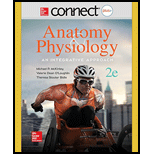
Connect Access Card for Anatomy & Physiology
2nd Edition
ISBN: 9781259133008
Author: Michael McKinley, Valerie O'Loughlin, Theresa Bidle
Publisher: McGraw-Hill Education
expand_more
expand_more
format_list_bulleted
Concept explainers
Question
Chapter 18.1, Problem 1WDYL
Summary Introduction
To determine:
The materials that are transported by the blood.
Concept introduction:
Blood is a type of circulatory fluid of vertebrate animals. It is found in the closed circulatory system as it is always present inside the blood vessels. Blood have pigments which help in removing carbon dioxide from the cells and transport oxygen and nutrients to them.
Expert Solution & Answer
Want to see the full answer?
Check out a sample textbook solution
Students have asked these similar questions
please draw in what the steps are given.
Thank you!
please draw in and fill out the empty slots from image below.
thank you!
There is a species of eagle, which lives in a tropical forest in Brazil. The alula pattern of its wings is determined by a single autosomal gene with four alleles that exhibit an unknown hierarchy of dominance. Genetic testing shows that individuals 1-1, 11-4, 11-7, III-1, and III-4 are each homozygous.
How many possible genotypes among checkered eagles in the population?
Chapter 18 Solutions
Connect Access Card for Anatomy & Physiology
Ch. 18.1 - Prob. 1WDYLCh. 18.1 - How does blood help regulate body temperature and...Ch. 18.1 - Will blood be able to properly carry out its...Ch. 18.1 - Prob. 4WDYLCh. 18.1 - Prob. 5WDYLCh. 18.2 - Prob. 6WDYLCh. 18.2 - Prob. 7WDYLCh. 18.2 - Prob. 8WDYLCh. 18.3 - What are the two main types of precursor cells for...Ch. 18.3 - Prob. 11WDYL
Ch. 18.3 - Prob. 12WDYLCh. 18.3 - Prob. 13WDYLCh. 18.3 - Prob. 14WDYLCh. 18.3 - Prob. 15WDYLCh. 18.3 - Prob. 16WDYLCh. 18.3 - Describe the process of erythropoiesis, beginning...Ch. 18.4 - Prob. 17WDYLCh. 18.4 - Prob. 18WDYLCh. 18.4 - Prob. 19WDYLCh. 18.4 - Prob. 20WDYLCh. 18.4 - At what point in blood loss is the sympathetic...Ch. 18.4 - Prob. 22WDYLCh. 18.5 - Prob. 23WDYLCh. 18.5 - Prob. 24WDYLCh. 18 - Prob. 1DYKBCh. 18 - _____ 2. Which type of leukocyte increases during...Ch. 18 - Prob. 3DYKBCh. 18 - Prob. 4DYKBCh. 18 - Prob. 5DYKBCh. 18 - Prob. 6DYKBCh. 18 - Prob. 7DYKBCh. 18 - _____ 8. During the recycling of components...Ch. 18 - _____ 9. The extrinsic pathway of coagulation is...Ch. 18 - _____ 10. A clot is best described as a. an...Ch. 18 - How does blood help regulate body temperature?Ch. 18 - What are alpha- and beta-globulins? What do they...Ch. 18 - When blood is centrifuged, a thin, whitish-gray...Ch. 18 - What is the shape of an erythrocyte, and why is...Ch. 18 - How are respiratory gases (oxygen and carbon...Ch. 18 - What are the anatomic characteristics of each type...Ch. 18 - How do the functions of basophils differ from...Ch. 18 - Briefly describe the origin, structure, and...Ch. 18 - Prob. 19DYKBCh. 18 - Describe the three phases of hemostasis, and list...Ch. 18 - Use the following paragraph to answer questions...Ch. 18 - Prob. 2CALCh. 18 - Which sequence or pathway best describes the...Ch. 18 - Prob. 4CALCh. 18 - Prob. 5CALCh. 18 - While taking a clinical laboratory class, Marilyn...Ch. 18 - Abby is a nurse on duty in a hospital emergency...Ch. 18 - Prob. 3CSL
Knowledge Booster
Learn more about
Need a deep-dive on the concept behind this application? Look no further. Learn more about this topic, biology and related others by exploring similar questions and additional content below.Similar questions
- students in a science class investiged the conditions under which corn seeds would germinate most successfully. BAsed on the results which of these factors appears most important for successful corn seed germination.arrow_forwardI want to write the given physician orders in the kardex formarrow_forwardAmino Acid Coclow TABle 3' Gly Phe Leu (G) (F) (L) 3- Val (V) Arg (R) Ser (S) Ala (A) Lys (K) CAG G Glu Asp (E) (D) Ser (S) CCCAGUCAGUCAGUCAG 0204 C U A G C Asn (N) G 4 A AGU C GU (5) AC C UGA A G5 C CUGACUGACUGACUGAC Thr (T) Met (M) lle £€ (1) U 4 G Tyr Σε (Y) U Cys (C) C A G Trp (W) 3' U C A Leu בוט His Pro (P) ££ (H) Gin (Q) Arg 흐름 (R) (L) Start Stop 8. Transcription and Translation Practice: (Video 10-1 and 10-2) A. Below is the sense strand of a DNA gene. Using the sense strand, create the antisense DNA strand and label the 5' and 3' ends. B. Use the antisense strand that you create in part A as a template to create the mRNA transcript of the gene and label the 5' and 3' ends. C. Translate the mRNA you produced in part B into the polypeptide sequence making sure to follow all the rules of translation. 5'-AGCATGACTAATAGTTGTTGAGCTGTC-3' (sense strand) 4arrow_forward
- What is the structure and function of Eukaryotic cells, including their organelles? How are Eukaryotic cells different than Prokaryotic cells, in terms of evolution which form of the cell might have came first? How do Eukaryotic cells become malignant (cancerous)?arrow_forwardWhat are the roles of DNA and proteins inside of the cell? What are the building blocks or molecular components of the DNA and proteins? How are proteins produced within the cell? What connection is there between DNA, proteins, and the cell cycle? What is the relationship between DNA, proteins, and Cancer?arrow_forwardWhy cells go through various types of cell division and how eukaryotic cells control cell growth through the cell cycle control system?arrow_forward
arrow_back_ios
SEE MORE QUESTIONS
arrow_forward_ios
Recommended textbooks for you
 Human Biology (MindTap Course List)BiologyISBN:9781305112100Author:Cecie Starr, Beverly McMillanPublisher:Cengage Learning
Human Biology (MindTap Course List)BiologyISBN:9781305112100Author:Cecie Starr, Beverly McMillanPublisher:Cengage Learning Human Physiology: From Cells to Systems (MindTap ...BiologyISBN:9781285866932Author:Lauralee SherwoodPublisher:Cengage Learning
Human Physiology: From Cells to Systems (MindTap ...BiologyISBN:9781285866932Author:Lauralee SherwoodPublisher:Cengage Learning


Human Biology (MindTap Course List)
Biology
ISBN:9781305112100
Author:Cecie Starr, Beverly McMillan
Publisher:Cengage Learning




Human Physiology: From Cells to Systems (MindTap ...
Biology
ISBN:9781285866932
Author:Lauralee Sherwood
Publisher:Cengage Learning